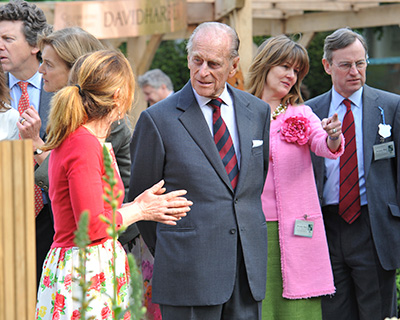RHS pays tribute to the late Duke of Edinburgh
It was with great sadness and deep respect that the RHS marked the passing of His Royal Highness, The Prince Philip, Duke of Edinburgh, who died on Friday, 9 April 2021
His Royal Highness was a dedicated campaigner for the conservation of our natural world. He pioneered the path to climate activism, devoting himself to raising public awareness of the complex relationship between humanity and the environment.
Throughout his lifetime, the Duke supported and worked closely with many organisations concerned with the protection of the world’s flora and fauna and was International President of the World Wildlife Fund from 1981 until 1996.
He was the longest serving British Royal consort and his unwavering devotion to the late Queen Elizabeth II, Patron of the Royal Horticultural Society, and to public duty, was an inspiration for many and evident throughout their life together.
Over the years, until he retired from royal duties in 2017, Prince Philip attended the RHS Chelsea Flower Show alongside Queen Elizabeth, and inspected the gardens and floral displays with enthusiasm and the keen eye for detail he was renowned for.
The Duke was also present when Queen Elizabeth planted a purple beech (Fagus sylvatica ‘Dawyck Purple’) in the Jubilee Arboretum at RHS Wisley in May 1978 and when she opened The Glasshouse there on 26 June 2007, to mark the bicentenary of the foundation of the RHS.
Life of The Duke
Prince Philip was born on 10 June 1921 on Corfu, the only son of Prince Andrew of Greece and Denmark and his wife, Princess Alice of Battenberg. His family fled Greece soon after his birth, and he was brought up first in France, then England, and educated at Gordonstoun School in Scotland and the Royal Naval College at Dartmouth.
He saw active service as a naval officerduring the Second World War, and was mentioned in dispatches. In 1947, when he became officially engaged to Princess Elizabeth, he renounced his European titles and took British citizenship. He was made a duke, with the title of Edinburgh, by King George VI, on 20 November 1947, the day of his marriage to Princess Elizabeth.
Although he left the Navy when his wife succeeded her father in 1952, his support of the Armed Forces continued throughout his life, with a number of honorary appointments, such as Colonel of the Grenadier Guards.
A lasting legacy
While serving in the Navy, Prince Philip developed an interest in science, engineering and industry. After he visited Antarctica and the South Atlantic in 1956–57, he worked hard to raise public awareness of the importance of conserving the natural world, as well as the complex relationship between humanity and the environment. These preoccupations remained important to him throughout his life.
In 1956, he founded what may be his most enduring legacy. The Duke of Edinburgh Award encourages young people to take an active role in sports and in their community, in the process building their own confidence and skills through learning, adventure and volunteering. More than 20,000 young people participate each year.
His interests were reflected in the more than 800 charities of which he was a member, Patron or President. Of those, some 21 were concerned with the conservation of flora and fauna, and included honorary membership of the Linnean Society as well as the Zoological Society of London.
An RHS Chelsea Flower Show regular
Prince Philip’s passion for conservation, at a time when the cause was not fashionable, is illustrated by his important support of the World Wildlife Fund, from its very beginning in 1961.
He became President of the British National Appeal, the first national organisation of the WWF, and remained President until 1982. Support from the Royal family for this cause continues with HRH Prince Charles and HRH the Duke of Cambridge.
Prince Philip was a regular attendee at the RHS Chelsea Flower Show, missing only one year (2005) since 1997. With Her Majesty, he attended the evening preview of the RHS London Show and Bicentenary Launch at Lawrence Hall in February 2004.
To commemorate the Queen’s Diamond Jubilee in 2012, Prince Philip and Queen Elizabeth each signed a Royal Autograph, painted on vellum, as they have been since 1816 when the tradition began. These are held in the RHS Lindley Library, London and are decorated with a border featuring plants from the Commonwealth, such the bright orange Caesalpinia pulcherrima for Barbados and the yellow-flowering Sophora microphylla for New Zealand. They were painted by the botanical artist, Gillian Barlow.
Soon after his retirement from public duties, Prince Philip was appointed Knight Grand Cross of the Royal Victorian Order, which is in the monarch’s gift. He was the first British national since the Earl Mountbatten, his uncle, to wear the breast stars of four orders of British chivalry.

